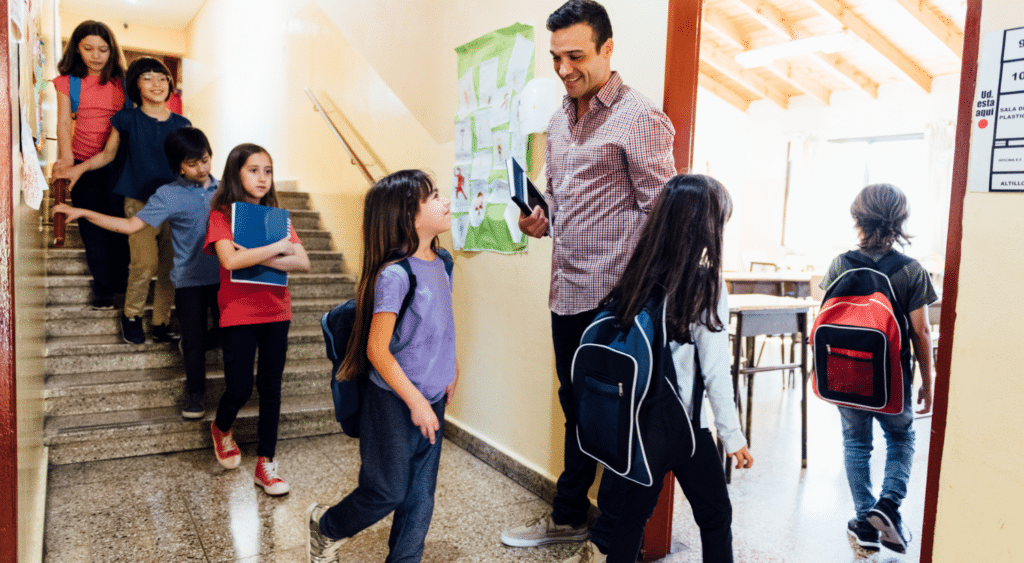Substitute teaching tips: How to resolve conflict between students.

Whether you’re working with kindergartners or high school seniors, disagreements between students are inevitable. While some can be quickly squashed with a stern look, as a substitute teacher, you need to know how to resolve conflict between students—quickly.
Understanding basic classroom management skills to resolve conflict between students will help you support students and teach them valuable interpersonal skills.
Here, we’ll explore the common types of conflicts in the classroom when substitute teaching. We’ll also review signs of escalation and look at some tried-and-true strategies to help your students respectfully resolve issues.
Common classroom conflicts.
Classroom conflicts typically fall into three categories: verbal, non-verbal, and physical.
- Verbal conflicts may involve raised voices, interruptions, heated debates, demeaning language, and persistent opposition to another student’s idea or opinion. Tuning into these factors can help you quickly identify and de-escalate verbal confrontations before they turn into larger issues.
- Non-verbal conflicts can be more difficult to spot. You might notice one student or group of students glaring at another student, turning away or rolling their eyes when the student is talking, purposefully leaving a student or group of students out of an activity, and mocking/mimicking a student. These types of conflicts can be tough to mitigate, as students may claim their behavior was unrelated to a conflict.
- Physical conflicts involve punching, pushing, kicking, or other forms of physical aggression. Precursors to actual physical confrontation can include threatening language and posturing, like standing in an intimidating way near another student.
Occasionally, classroom confrontations can occur, especially if students have had prior issues, had a conflict in another class period, in the hallway, etc. Typically, you’ll see warning signs that a classroom conflict is escalating.
Signs that a confrontation is increasing in intensity.
- Increased volume or emotion in voice or gestures
- Asking others to join the conflict (take sides)
- Standing up out of the seat
- Shouting
- Crying
How to resolve conflict between students: key strategies.
Managing conflicts can be one of the more challenging aspects of your substitute teacher duties. Having the right strategies in your back pocket can help you manage classroom issues effectively and professionally. Let’s explore some tactics you can use to pause, de-escalate, and resolve classroom confrontation between students.
Stay calm and neutral.
Students take cues from your tone and body language. If you’re confident in your ability to handle a classroom conflict, students will follow your lead. Maintain your composure, don’t take sides, and be clear about your expectations. If students notice you seem flustered or uncertain regarding your next steps, the conflict may more rapidly escalate.
Assess the situation quickly.
Carefully and quickly decide what type of intervention needs to happen to resolve a student conflict. For example, a student rolling their eyes at a classmate may be resolved with a quick redirection from you. A screaming match that’s likely to become physical will require a call to the office. Be ready to change your plan if your first intervention doesn’t work.
Separate students if necessary.
Separating students can help calm a situation quickly. Do not intervene or physically contact the students. Instead, direct one (or both) of them to move to a new seat, ask a neighboring teacher if a student can be in their room for a bit, or allow one to go for a quick drink of water and cool off.
Focus on the behavior, not the person.
Using behavior-first language rather than person-first language can help to de-escalate a conflict. For example, saying, “Name calling is never acceptable in this classroom,” is a better choice than “You’re a bully—stop it” to address a situation of name calling.
Encourage problem-solving.
Talking privately to the students involved in the conflict can help guide them to a peaceful resolution. Reflecting on each student’s feelings out loud can help both students feel heard and develop empathy for each other.
For example, suppose one student makes fun of another for incorrectly answering a question. In that case, you might help the offending party empathize by saying something like,
“From what she said, I’m hearing that Serena feels hurt and embarrassed that you laughed when she didn’t answer the question correctly, and it’s making her feel nervous about participating in class. Serena, does that sound right?”
Using these think-alouds can help facilitate productive communication and break negative patterns that keep students at odds.
Follow the school’s discipline policy.
As a substitute teacher, understanding the school’s discipline policy is a key part of your duties. When students see that you’re “in the know” regarding what’s acceptable in their school and what’s not, they’ll be more likely to act respectfully, both to you and their peers.
If a situation escalates beyond your ability to facilitate a peaceful resolution, involve the appropriate school staff immediately. Err on the side of caution here. It’s better to take conflicts too seriously than to find yourself in over your head when confrontations are on the brink of becoming physical.
Model respectful communication.
Embodying the type of communication you want in your classroom helps you serve as a positive role model for your students. Treat each student with patience and respect, even when (especially when) they’re struggling to do the same.
Document and report serious incidents.
Conflicts that escalate beyond typical back-and-forth classroom arguments need to be reported to both the school administration and (if you work for us) Kelly Education. Document the details of any conflicts that involve threats, bullying, and/or physical harm. Report these issues immediately.
Reinforce positive behavior.
Praise efforts to resolve conflicts peacefully. Remember, students are still learning how to communicate, and you may witness their honest best effort to resolve a conflict peacefully. Praising what they did well can help them understand what they’re doing right and can help them continue such behaviors in the future.
Grow as a substitute teacher with Kelly Education.
As a substitute teacher, classroom management—including conflict management—is a key aspect of creating a productive, safe, welcoming classroom for students. Learn other classroom management techniques in these articles:
Considering work in schools as a substitute teacher, tutor, or paraeducator? Fill out our brief interest form. One of our recruiters will contact you to share more about the requirements and process to work at one of our partner schools.
View Related: Article Workplace culture
You might like
Find your next job
Discover thousands of temporary, full-time, and remote jobs for beginning and experienced job seekers.



